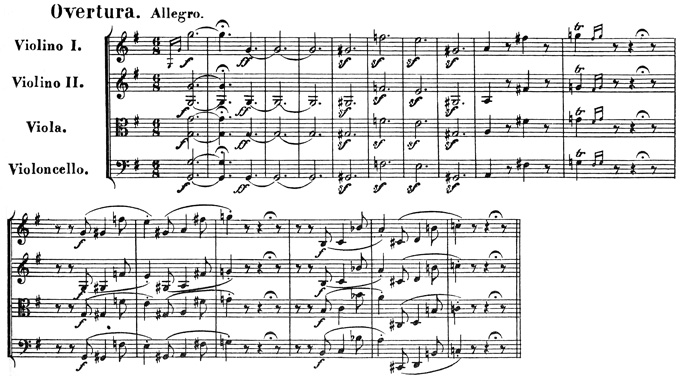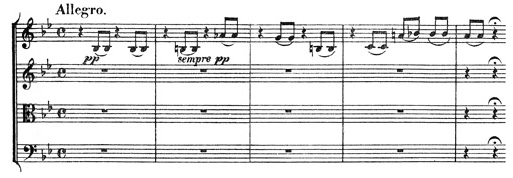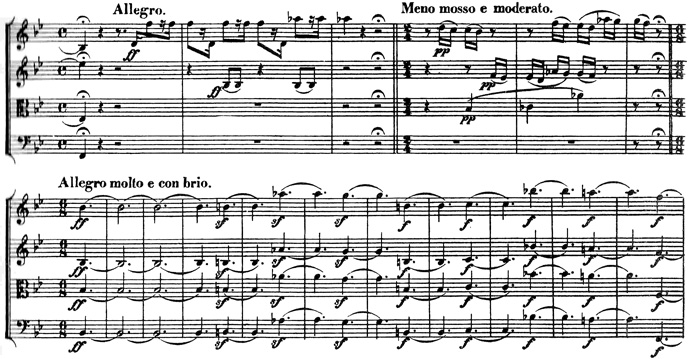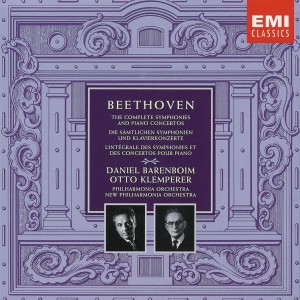Ludwig van Beethoven
String Quartet in B♭ major, op.133, “Great Fugue”
Media Review / Comparison
2013-02-02 — Original posting (on Blogger)
2013-02-05 — Added results of a radio comparison, featuring 5 of the recordings below
2013-08-07 — New standard layout applied
2013-11-10 — Added Otto Klemperer’s interpretation of the version for orchestra
2014-11-07 — Re-posting as is (WordPress)
2016-07-11 — Brushed up for better readability
2019-01-23 — Added the recording with the Quatuor Mosaïques (2016)
Table of Contents
- Introduction / The Recordings
- The Composition
- Timing Comparison
- Comments on the Individual Recordings
- Amadeus Quartet (1962)
- Guarneri String Quartet (1969)
- Emerson String Quartet (1997)
- LaSalle Quartet (1972)
- Quartetto Italiano (1969)
- Endellion String Quartet (2006)
- Otto Klemperer, Philharmonia Orchestra (1956)
- Adolf Busch, The Busch Chamber Players (1941)
- Alban Berg Quartett (1983)
- Takács Quartet (2004)
- Leipziger Streichquartett (2006)
- Melos Quartett Stuttgart (1985)
- Artemis Quartet (2009)
- Hagen Quartett (2001)
- Quatuor Mosaïques (2016)
- Addendum 1:
- Addendum 2:
Introduction / The Recordings
Here’s another note on the recordings of Beethoven’s string quartets in my music collection, about the quartet in B♭ major, op.133, “Great Fugue” — references to the CDs are given at the bottom of the respective section, or in one of the related postings, or see the summary on the postings covering Beethoven’s String Quartets. Here’s a short list of the recordings in this comparison, in alphabetic order:
- Alban Berg Quartett (1983)
- Amadeus Quartet (1962)
- Artemis Quartet (2011)
- Busch Chamber Players (1941)
- Emerson String Quartet (1997)
- Endellion String Quartet (2006)
- Guarneri String Quartet (1969)
- Hagen Quartett (2001)
- LaSalle Quartet (1972)
- Leipziger Streichquartett (2006)
- Melos Quartett (1984)
- Otto Klemperer, Philharmonia Orchestra (1956)
- Quartetto Italiano (1969)
- Quatuor Mosaïques (2016)
- Takács Quartet (2004)
The Composition
The String Quartet in B♭ major, op.133, “Great Fugue” by Ludwig van Beethoven (1770 – 1827) was first conceived as final movement to the string quartet in B, op.130; after some persuading by friends (who found that movement unintelligible, or too difficult for the public back then), Beethoven decided to write a new Finale for that quartet, and to publish the Great Fugue as separate composition.
Many quartets will still use the Great Fugue as final movement to op.130, though — I decided to do the review as the quartets were published, hence this review for a single quartet movement, featuring the main sections outlined below. I don’t want to write too much of an analysis — this has been done by others: there is a lot of literature on this composition (you may take this Wikipedia article or this one in German as entry point).
The Movement(s)
Overtura: Allegro (6/8) — Meno mosso e moderato (2/4) —
Allegro — Fuga (4/4) —
Meno mosso e moderato (2/4) —
Allegro molto e con brio (6/8) —
Meno mosso e moderato (2/4) —
Allegro molto e con brio (6/8) —
Allegro (4/4) — Meno mosso e moderato (2/4) — Allegro molto e con brio (6/8)
Difficult to Understand?
The Great Fugue is widely known as being “difficult”, if not “incomprehensible”; yes, it is difficult and demanding for the musicians, it’s musical language is often harsh, relentless — but aren’t there such difficult sections in other compositions by Beethoven and his contemporaries as well? I personally find other quartet movements by the same composer just as difficult than this one (if not even more) — and after all, there are definitely also many “bright” moments / sections in this piece, let alone the almost jubilant ending (through darkness into the light)!
Plus, I don’t think access to this piece requires a detailed analysis or understanding: it is impossible to capture / recognize every appearance of the fugue theme in all its variations (inverted, stretched, backwards, etc.) — as a fugue, this is just as much of a masterpiece as Bach’s late fugues: just try to immerse into the composition, let yourself be surprised about the appearance of the fugue theme in its many forms, and with its various accompanying (comēs, i.e., companion) themes, in all these rhythmic intricacies — it’s an absolutely fascinating piece of music.
Part of the String Quartet op.130?
In many ways, I think this has outgrown the frame of op.130 — and I’m sure that ultimately, Beethoven realized that, too, and hence agreed to publishing it as stand-alone composition. Yes, there are ties that link this movement to op.130 — but then such thematic allusions also occur in several others of Beethoven’s late string quartets: some of this is just his language in this period of his life.
Timing Comparison
As one of the few things that one can actually “measure” in music performances, I’m giving the approximate metronome numbers for three key sections (the initial Fugue and the two major sections that follow) in the text below. As these numbers are spread over the text, I felt it would help if I collected them in a table, shown below. I have used color coding to indicate relative rates: white would be the average tempo, blue fields are slower tempi, green indicates faster-than-average performances (where the strength of the color indicates the amount of deviation from the average). Click on table for full size view:
Comments on the Individual Recordings
The order of the interpretations is not chronological (neither by recording / publishing date nor by purchase date), but follows my personal, subjective rating, my preferred recording shownlast:
Amadeus Quartet (1962)
Beethoven: The String Quartets (opp. 18, 59, 74, 95, 127, 130-133, 135)
DG 463 143-2 (stereo, 7 CD); ℗ 1962 / © 1974

Recorded in 1962, with Norbert Brainin, Siegmund Nissel, Peter Schidlof, Martin Lovett — for general comments see op.18/1.
Notes on the Performance
The articulation is superficial, even sloppy, rhythmically inaccurate, clearly unacceptable, and also the intonation is not clean, especially in the fast parts; the Meno mosso e moderato is somewhat better.
| Tempi: | 1/4 = 130 (Fuga) — 1/4 = 50 (Meno mosso e moderato) — 3/8 = 148 (Allegro molto e con brio) |
| Duration: | 15’20” (6 tracks) |
| Recommendation: | Definitely not |
| Rating: | 2.0 (1 / 3 / 1 / 2 / 2 / 3) |
Guarneri String Quartet (1969)
Beethoven: The Late String Quartets, opp. 127, 130-133, 135
RCA Victor / BMG Classics 60458-2-RG (stereo, 3 CD); ℗ / © 1990

Recorded in 1969, with Arnold Steinhardt, John Dalley, Michael Tree, David Soyer — for general comments see op.127.
Notes on the Performance
The fugue is rough, the cello (and sometimes also other voices) are not always clean, the articulation sometimes superficial; the Meno mosso e moderato would profit from additional differentiation between the voices; the Allegro molto e con brio is played “monumentally” — too gross, and it often sounds like 5 voices, taking into account the moaning of the cellist!
| Tempi: | 1/4 = 122 (Fuga) — 1/4 = 47 (Meno mosso e moderato) — 3/8 = 140 (Allegro molto e con brio) |
| Duration: | 16’46” |
| Recommendation: | No |
| Rating: | 2.0 |
Emerson String Quartet (1997)
Beethoven: The String Quartets (opp. 18, 59, 74, 95, 127, 130-133, 135)
DG 447 075-2 (stereo, 7 CD); ℗ 1996

Recorded in 1997, with Eugene Drucker, Philip Setzer, Lawrence Dutton, David Finckel — for general comments see op.18/1.
Notes on the Performance
An awful, broad / heavy vibrato — clearly affecting the intonation. They try indicating two quavers in those paired (slurred) notes in the fugue — but that’s exaggerated, sometimes sounding like a monotonous chain of quavers. To me, their articulation is sloppy, way too soft. The rating below is generous.
| Tempi: | 1/4 = 128 (Fuga) — 1/4 = 60 (Meno mosso e moderato) — 3/8 = 166 (Allegro molto e con brio) |
| Duration: | 14’54” |
| Recommendation: | No |
| Rating: | 3.0 |
LaSalle Quartet (1972)
Beethoven: The Late String Quartets (opp. 127, 130, 131, 132, 133, 135)
Brilliant Classics 94064 (3 CDs); ℗ / © 1997 (Deutsche Grammophon)

Recorded in 1972, with Walter Levin, Henry W. Meyer, Peter Kamnitzer, Jack Kirstein — for general comments see op.127.
Notes on the Performance
In the fugue, the cello is sometimes not quite clean; the Allegro molto e con brio is rhythmically rigid and has some superficialities in the articulation.
| Tempi: | 1/4 = 120 (Fuga) — 1/4 = 43 (Meno mosso e moderato) — 3/8 = 164 (Allegro molto e con brio) |
| Duration: | 16’12” |
| Recommendation: | So – so … |
| Rating: | 3.0 |
Quartetto Italiano (1969)
Beethoven: Complete String Quartets (opp. 18, 59, 74, 95, 127, 130-133, 135)
Decca 454 062-2 (stereo, 10 CD); ℗ 1972 / © 1996

Recorded in 1969, with Paolo Borciani, Elisa Pegreffi, Piero Farulli, Franco Rossi — for general comments see op.18/1.
Notes on the Performance
The fugue is played pretty rough, coarse; the Meno mosso e moderato is very slow — slower than anybody else, and half as fast as the Hagen Quartett; some sections in the Allegro molto e con brio are rather heavy.
| Tempi: | 1/4 = 120 (Fuga) — 1/4 = 35 (Meno mosso e moderato) — 3/8 = 146 (Allegro molto e con brio) |
| Duration: | 18’51” |
| Recommendation: | Not really |
| Rating: | 3.0 |
Endellion String Quartet (2006)
Beethoven: Complete String Quartets, Quintets & Fragments
WCJ (Warner Classics & Jazz) 2564 69471-3 (stereo, 10 CD); ℗ / © 2008

Recorded in 2006, with Andrew Watkinson, Ralph de Souza, Garfield Jackson, David Waterman — for general comments see op.18/1.
Notes on the Performance
They master the fugue very well (with some slight slowdowns and minor intonation issues, though) — but interestingly, the articulation in the Meno mosso e moderato is not always precise, if not occasionally a bit sloppy. The Allegro molto e con brio is a bit schematic, the articulation could sometimes be somewhat better.
| Tempi: | 1/4 = 136 (Fuga) — 1/4 = 50 (Meno mosso e moderato) — 3/8 = 150 (Allegro molto e con brio) |
| Duration: | 15’52” |
| Recommendation: | Mixed feelings … mostly OK |
| Rating: | 3.0 |
Otto Klemperer, Philharmonia Orchestra (1956)
Beethoven: The Complete Symphonies and Piano Concertos; Choral Fantasia; Great Fugue op.133; Overtures Leonore 1-3, Coriolan, Prometheus
Otto Klemperer, Philharmonia Orchestra, Daniel Barenboim
EMI 5 73895 2 (9 CDs, stereo); ℗ / © 2000

Recorded in 1956 — for comments on a different piece from the same CD set see my comments on Beethoven’s Music for the Ballet “Die Geschöpfe des Prometheus”, op.43.
This recording is really “hors concours”, as this is Felix Weingartner’s (1863 – 1942) version for string orchestra, see also the comments on the interpretation below. I missed Klemperer’s recording in the initial review, as it was archived under “orchestral music”…
Notes on the Performance
Adolf Busch (see the review below) uses his Chamber Players, i.e., a relatively small orchestra; this has the advantage of being more direct, more transparent, more flexible — at the expense of some tonal purity: 2 – 3 string instruments per voice in this demanding piece is often stressing the intonation. Otto Klemperer on the other hand uses a really big orchestra, making this piece as monumental as it can possibly be: relatively slow tempi, especially in the Allegro molto e con brio part, massive string voices.
I’m sure Klemperer used his “classic” setup with 8 – 10 double basses, aligned in a row behind the center of the orchestra. Also the articulation (more legato than the other interpretations) makes this sound heavy — and the transparency is suffering. On the other hand, the large number of string players makes each voice sound very homogeneous (and massive). The heavy, monumental setting is certainly what Felix Weingartner had in mind — one should not compare this with the string quartet interpretations. What I criticize in this interpretation, though (on top of the limited transparency), is that it tends to lose drive and sometimes tends to be rather static, especially in the Allegro molto e con brio part.
| Tempi: | 1/4 = 116 (Fuga) — 1/4 = 56 (Meno mosso e moderato) — 3/8 = 120 (Allegro molto e con brio) |
| Duration: | 16’30” |
| Recommendation: | Interesting, but definitely not the same piece! |
| Rating: | 3.0 |
Adolf Busch, The Busch Chamber Players (1941)
Beethoven: The Late Quartets opp.95, 127, 130, 131, 132, 133, 135
Adolf Busch, The Busch Chamber Players
(Busch Quartett)
Pearl, Pavilion Records Ltd., GEMS 0053 (3 CDs); ℗ 1999

Recorded in 1941 — for general comments see op.95.
Notes on the Performance
This recording is somewhat “hors concours”, as Adolf Busch did not record this with his string quartet — he rather recorded Felix Weingartner’s (1863 – 1942) version for string orchestra with the Busch Chamber Players. It is mostly the same composition — the adaptation mostly concerns the addition of a double bass voice, and some minor adaptations (like: one general break is missing in order to make the flow more dramatic). How does this sound? Well, the fugue certainly is even more monumental than already in the quartet setting — rather “thick”, “grand orchestra style”, the articulation rather static; the orchestra tends to be less transparent than a quartet.
There are some subtle slowdowns — it is not clear whether these run under rubato / agogics, or whether they just reflect the technical difficulties in this piece (I doubt that Adolf Busch would drop the tempo for technical reasons!). The Meno mosso e moderato loses some intimacy / personality in the orchestral setting; the Allegro molto e con brio is very expressive, with big phrases and a dramatic climax. A very interesting recording overall, impressive — and more of a pleasure to listen to than many of the “classical” quartet recordings!
| Tempi: | 1/4 = 110 (Fuga) — 1/4 = 48 (Meno mosso e moderato) — 3/8 = 148 (Allegro molto e con brio) |
| Duration: | 16’25” |
| Recommendation: | Very interesting, though not really the same piece! |
| Rating: | 4.0 |
Alban Berg Quartett (1983)
Beethoven: The Late String Quartets (opp. 127, 130-133, 135)
EMI CDS 7 47135 8 (stereo, 4 CD); ℗ 1982 – 1984

Recorded in 1983, with Günther Pichler, Gerhard Schulz, Thomas Kakuska, Valentin Erben — for general comments see op.127.
Notes on the Performance
A “classic” (in the sense of traditional) interpretation, technically very good, precise, reasonably transparent, occasionally with an excess of vibrato (but still acceptable, mostly). The rating below is generous.
| Tempi: | 1/4 = 130 (Fuga) — 1/4 = 57 (Meno mosso e moderato) — 3/8 = 146 (Allegro molto e con brio) |
| Duration: | 15’37 |
| Recommendation: | Certainly an option if you prefer traditional performances |
| Rating: | 4.0 |
Takács Quartet (2004)
Beethoven: The Late String Quartets (opp. 95, 127, 130 – 133, 135)
Decca 470 849-2 (stereo, 3 CD); ℗ / © 2004

Recorded in 2004, with Edward Dusinberre, Károly Schranz, Roger Tapping, András Fejér — for general comments see op.95.
Notes on the Performance
The fast / fortissimo parts are mostly OK, in the Meno mosso e moderato parts there is definitely too much vibrato. The interpretation is dramatic, exhibiting the big phrases, though there are some rushed / pushed sections, and overall, the articulation is not consequent (like: the pairs of quavers under a slur are not done the same way between voices, nor even within one voice, throughout the piece. The rating below is generous.
| Tempi: | 1/4 = 148 (Fuga) — 1/4 = 54 (Meno mosso e moderato) — 3/8 = 166 (Allegro molto e con brio) |
| Duration: | 14’34” |
| Recommendation: | Only with reservations. |
| Rating: | 4.0 |
Leipziger Streichquartett (2006)
Beethoven: String Quartets opp. 130 & 133
Musikproduktion Dabringhaus und Grimm, MDG 307 0851-2 (stereo); ℗ / © 2007

Recorded in 2006, with Andreas Seidel, Tilman Büning, Ivo Bauer, and Matthias Moosdorf — for general comments see op.130.
Notes on the Performance
A pretty good interpretation overall, with good, careful articulation in general — though with reverberation that is at the limit of becoming a distraction, and the vibrato is sometimes a bit strong. Also, those pairs of quavers in the first ff fugue part are not always done consequently; in these parts, they avoid making the articulation too rough, without making it too soft (though occasionally, in the ff parts, a slightly lighter articulation would increase the transparency). To be truthful, the rating would have to be slightly above 4.0 (I prefer this over the versions with the same rating above).
| Tempi: | 1/4 = 130 (Fuga) — 1/4 = 58 (Meno mosso e moderato) — 3/8 = 156 (Allegro molto e con brio) |
| Duration: | 14’54” |
| Recommendation: | A very good, “classical” interpretation |
| Rating: | 4.0 |
Melos Quartett Stuttgart (1985)
Beethoven: Die späten Streichquartette, opp.127, 130-133, 135
DG 415 676-1 (stereo, 3 CD); ℗ 1986

Recorded in 1985, with Wilhelm Melcher, Gerhard Voss, Hermann Voss, Peter Buck — for general comments see op.127.
Notes on the Performance
Emotional, expressive, very dramatic excellent, except for an excess of vibrato (especially in the Meno mosso e moderato parts) that sometimes also affects the intonation. But overall, a very good (though still traditional) interpretation. In the fugue, they play the linked quavers (see the score example above) under a slur “semi-detached”, i.e., indicating two notes rather than a single one (if the latter was required, Beethoven would certainly have written a quarter note). I like their dramatic accelerando in the second Meno mosso e moderato!
| Tempi: | 1/4 = 126 (Fuga) — 1/4 = 53 (Meno mosso e moderato) — 3/8 = 148 (Allegro molto e con brio) |
| Duration: | 15’14” (6 tracks) |
| Recommendation: | Yes, for me one of the best traditional interpretations! |
| Rating: | 4.2 (4 / 4 / 4 / 5 / 4 / 4) |
Artemis Quartet (2009)
Beethoven: String Quartets opp. 18/6, 130, 133;
Virgin Classics 50999 69458 0 8 (stereo); ℗ / © 2010

Recorded in 2009, with Natalia Prischepenko, Gregor Sigl, Friedemann Weigele, Eckart Runge — for general comments see op.18/6.
Notes on the Performance
Excellent interpretation with very good, clear articulation, excellent transparency (as much as possible with this composition!) and phrasing, with lots of attack, technically almost flawless (as much as possible in this piece!). One could argue that with specific (especially long) notes the vibrato is at or above the limit — but then, there are also stretches with virtually no vibrato. A dramatic, masterful, coherent performance.
| Tempi: | 1/4 = 140 (Fuga) — 1/4 = 51 (Meno mosso e moderato) — 3/8 = 160 (Allegro molto e con brio) |
| Duration: | 15’03” |
| Recommendation: | Excellent; I would still call this a traditional / classic (not a revolutionary) interpretation. |
| Rating: | 5.0 |
Hagen Quartett (2001)
Bach: 5 Fugues BWV 871, 874, 876 – 878; Mozart: Adagio & Fugue K.546; Beethoven: String Quartets opp. 130 & 133
DG 471 580-2 (stereo); ℗ / © 2002

Recorded in 2001, with Lukas Hagen, Rainer Schmidt, Veronika Hagen, and Clemens Hagen — for general comments see op.130.
Notes on the Performance
Just simply excellent! Just their virtuosity alone is astounding: they are among the fastest performers in this piece — yet they manage clarity in their articulation, transparency (as much as possible in this composition!), agogics (even accelerandi!), and phrasing, and it’s not rushed or pushed. They are the most consequent in plying the paired quavers legato, but still recognizably as two notes, throughout the first ff part of the fugue.
Then there’s the Meno mosso e moderato: here, they are definitely the fastest (twice as fast as the Quartetto Italiano!) — however, their tempo choice is the most compelling one among all artists, in that the that part is not slow, but exactly at half the pace of the preceding fugue, and this feels absolutely logical and natural — and it makes those Meno mosso parts appear as variations within the fugue rather than as remotely related intermissions / disruptions. This description may give the impression of (their interpretation being seen as) an intellectual construct — but that’s not how I think about this interpretation: quite to the contrary — it is the most convincing one to me!
| Tempi: | 1/4 = 144 (Fuga) — 1/4 = 70 (Meno mosso e moderato) — 3/8 = 170 (Allegro molto e con brio) |
| Duration: | 13’26” |
| Recommendation: | Yes: clearly the top performance for me! |
| Rating: | 5.0 |
Quatuor Mosaïques (2016)
Beethoven: The Late String Quartets opp. 127, 130 – 133, 135
naïve V 5445 (3 CDs, stereo); ℗ 2014 – 2016 / © 2017

Recorded in 2016, with Erich Höbarth, Andrea Bischof, Anita Mitterer, Christophe Coin — for general comments see op.18/1. After reviewing and enjoying the first three CDs by this ensemble, I have long been waiting for additional, truly historically informed Beethoven recordings by this ensemble: very few, if any other quartet formations can compete with the Quatuor Mosaïques in this field. To me, all of their op.18 recordings have reference status.
Notes on the Performance
More than 10 years went by since the ensemble’s last Beethoven recording—and the artists demonstrate that they are still at the height of their abilities, and at the same time at the forefront of historically informed (HIP) music performances!
The artists keep the tempo moderate, as appropriate for period instruments and bows. Throughout the performance, vibrato is inconspicuous, rarely noticeable at all (and definitely never affecting the intonation). It may take a moment to get acquainted to the unadorned sound of the ensemble, which highlights dissonances. But then, one notices that the articulation is very careful throughout, attention is paid to details, as well as to the overall structure, the phrasing.
The ensemble, has a clear concept about the overall structure, and at the same time, the complex polyphony in the fugues remains outstandingly clear and transparent. Also, there is no violence, no relentless chasing through the fugues (as with some other ensembles), but theme entries etc. are highlighted with the help of agogics.
There is none of that crude, if not rude tone that some ensembles apply to the fugues (no, HIP doesn’t automatically imply “rough”!). The focus is not on “loud”, but on differentiation. At the “other end” there are these amazing, touching moments where the ensemble seems to retract into fines softness, e.g., right near the beginning, in the second Allegro, prior to the first Fuga, or, after that fugue, at the Meno mosso e moderato.
| Tempi: | 1/4 = 120 (Fuga) — 1/4 = 55 (Meno mosso e moderato) — 3/8 = 152 (Allegro molto e con brio) |
| Duration: | 15’56” |
| Recommendation: | Yes: A must for people who like or want historically informed (HIP) performances! |
| Rating: | 5.0 |
Addendum 1:
On 2013-02-04, the Great Fugue op.133 was discussed in “Diskothek im Zwei” on Radio SRF2; unfortunately (for the fugue, that is), the title “Zukunftsmusik: Beethovens grosse Fuge” does not tell the full truth: the discussion started off with five versions of the Great Fugue op.133, but then moved on to two movements of the String Quartet in B, op.130. Anyhow — the following recordings were discussed:
- Emerson String Quartet (1997)
- Hagen Quartett (2001)
- Alban Berg Quartet (1983)
- Artemis Quartet (2009)
- Leipziger Streichquartett (2006)
The Outcome of the Radio Comparison
This was a blind comparison with two experts. As is customary with this discussion round, a fist movement is discussed (after listening to samples only, not an entire movement, unless that is very short), then two recordings are eliminated. In the following round, a second movement is compared, another recording thrown out, and in the final round, using a third movement, the remaining two recordings are compared, and (usually) a winner / preferred recording is declared. Here’s how this comparison went:
- In the first round, the beginning of the fugue was played, up to bar #110 (excluding the Meno mosso e moderato section, unfortunately); recordings 2 and 4 were clear winners in that round, there was doubt as to whether to eliminate 1 & 3 or 3 & 5 — consensus was reached to eliminate #3 (Alban Berg Quartet) and #5 (Leipziger Streichquartett). The favorite in that round appeared to be #4 (Artemis Quartet), followed by #2 (Hagen Quartett).
- in the second round, the entire movement 2 (Presto) of op.130 was compared — and the first recording (Emerson String Quartet) fell out, Leaving Artemis and Hagen.
- In the final round, the last part of movement 5 (Cavatina) from op.130 was compared — and the two remaining contenders (Artemis Quartet and Hagen Quartett) finished almost ex aequo, with a slight preference for the Hagen Quartet, based on their interpretation of the Cavatina.
What if…
I suspect that if the Meno mosso e moderato had been included in the first round, the Hagen Quartett would have ended at the top, or at least on a par with the Artemis Quartet in that round, and might have been the winner overall — but overall, I consider this a clear confirmation for my findings!
Addendum 2:
I’m using pocket scores to follow this music while listening. The listing shows the volumes for all of Beethoven’s string quartets:
- op.18/1-6 (Kalmus pocket score No.759) —Find pocket score volume I on amazon.com—
- op.59/1-3 (Kalmus pocket score No.760) —Find pocket score volume II on amazon.com (#ad) —
- opp.74, 95, 127, 130 (Kalmus pocket score No.761) —Find pocket score volume III on amazon.com (#ad) —
- opp.131, 132, 133, 135 (Kalmus pocket score No.762) —Find pocket score volume IV on amazon.com (#ad) —










































